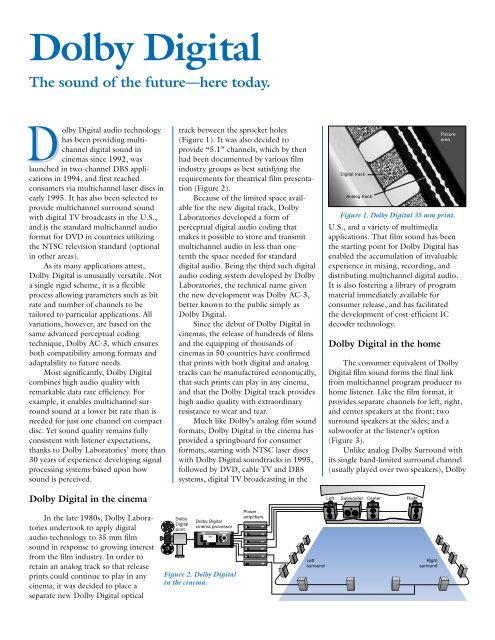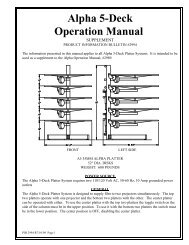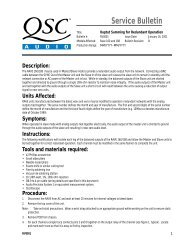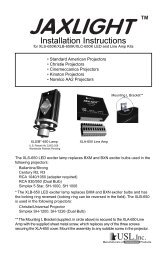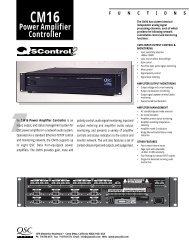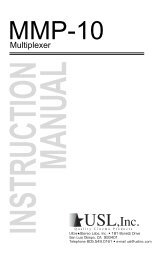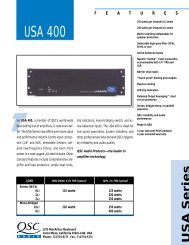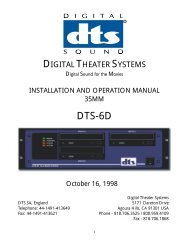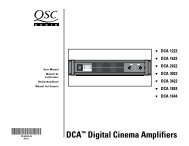Dolby Digital - R.S. Engineering and Manufacturing
Dolby Digital - R.S. Engineering and Manufacturing
Dolby Digital - R.S. Engineering and Manufacturing
You also want an ePaper? Increase the reach of your titles
YUMPU automatically turns print PDFs into web optimized ePapers that Google loves.
7.0<br />
<strong>Dolby</strong> <strong>Digital</strong><br />
The sound of the future—here today.<br />
<strong>Dolby</strong> <strong>Digital</strong> audio technology<br />
has been providing multichannel<br />
digital sound in<br />
cinemas since 1992, was<br />
launched in two-channel DBS applications<br />
in 1994, <strong>and</strong> first reached<br />
consumers via multichannel laser discs in<br />
early 1995. It has also been selected to<br />
provide multichannel surround sound<br />
with digital TV broadcasts in the U.S.,<br />
<strong>and</strong> is the st<strong>and</strong>ard multichannel audio<br />
format for DVD in countries utilizing<br />
the NTSC television st<strong>and</strong>ard (optional<br />
in other areas).<br />
As its many applications attest,<br />
<strong>Dolby</strong> <strong>Digital</strong> is unusually versatile. Not<br />
a single rigid scheme, it is a flexible<br />
process allowing parameters such as bit<br />
rate <strong>and</strong> number of channels to be<br />
tailored to particular applications. All<br />
variations, however, are based on the<br />
same advanced perceptual coding<br />
technique, <strong>Dolby</strong> AC-3, which ensures<br />
both compatibility among formats <strong>and</strong><br />
adaptability to future needs.<br />
Most significantly, <strong>Dolby</strong> <strong>Digital</strong><br />
combines high audio quality with<br />
remarkable data rate efficiency. For<br />
example, it enables multichannel surround<br />
sound at a lower bit rate than is<br />
needed for just one channel on compact<br />
disc. Yet sound quality remains fully<br />
consistent with listener expectations,<br />
thanks to <strong>Dolby</strong> Laboratories’ more than<br />
30 years of experience developing signal<br />
processing systems based upon how<br />
sound is perceived.<br />
track between the sprocket holes<br />
(Figure 1). It was also decided to<br />
provide “5.1” channels, which by then<br />
had been documented by various film<br />
industry groups as best satisfying the<br />
requirements for theatrical film presentation<br />
(Figure 2).<br />
Because of the limited space available<br />
for the new digital track, <strong>Dolby</strong><br />
Laboratories developed a form of<br />
perceptual digital audio coding that<br />
makes it possible to store <strong>and</strong> transmit<br />
multichannel audio in less than onetenth<br />
the space needed for st<strong>and</strong>ard<br />
digital audio. Being the third such digital<br />
audio coding system developed by <strong>Dolby</strong><br />
Laboratories, the technical name given<br />
the new development was <strong>Dolby</strong> AC-3,<br />
better known to the public simply as<br />
<strong>Dolby</strong> <strong>Digital</strong>.<br />
Since the debut of <strong>Dolby</strong> <strong>Digital</strong> in<br />
cinemas, the release of hundreds of films<br />
<strong>and</strong> the equipping of thous<strong>and</strong>s of<br />
cinemas in 50 countries have confirmed<br />
that prints with both digital <strong>and</strong> analog<br />
tracks can be manufactured economically,<br />
that such prints can play in any cinema,<br />
<strong>and</strong> that the <strong>Dolby</strong> <strong>Digital</strong> track provides<br />
high audio quality with extraordinary<br />
resistance to wear <strong>and</strong> tear.<br />
Much like <strong>Dolby</strong>’s analog film sound<br />
formats, <strong>Dolby</strong> <strong>Digital</strong> in the cinema has<br />
provided a springboard for consumer<br />
formats, starting with NTSC laser discs<br />
with <strong>Dolby</strong> <strong>Digital</strong> soundtracks in 1995,<br />
followed by DVD, cable TV <strong>and</strong> DBS<br />
systems, digital TV broadcasting in the<br />
<strong>Digital</strong> track<br />
Analog track<br />
U.S., <strong>and</strong> a variety of multimedia<br />
applications. That film sound has been<br />
the starting point for <strong>Dolby</strong> <strong>Digital</strong> has<br />
enabled the accumulation of invaluable<br />
experience in mixing, recording, <strong>and</strong><br />
distributing multichannel digital audio.<br />
It is also fostering a library of program<br />
material immediately available for<br />
consumer release, <strong>and</strong> has facilitated<br />
the development of cost-efficient IC<br />
decoder technology.<br />
<strong>Dolby</strong> <strong>Digital</strong> in the home<br />
Picture<br />
area<br />
Figure 1. <strong>Dolby</strong> <strong>Digital</strong> 35 mm print.<br />
The consumer equivalent of <strong>Dolby</strong><br />
<strong>Digital</strong> film sound forms the final link<br />
from multichannel program producer to<br />
home listener. Like the film format, it<br />
provides separate channels for left, right,<br />
<strong>and</strong> center speakers at the front; two<br />
surround speakers at the sides; <strong>and</strong> a<br />
subwoofer at the listener’s option<br />
(Figure 3).<br />
Unlike analog <strong>Dolby</strong> Surround with<br />
its single b<strong>and</strong>-limited surround channel<br />
(usually played over two speakers), <strong>Dolby</strong><br />
<strong>Dolby</strong> <strong>Digital</strong> in the cinema<br />
Left Subwoofer Center Right<br />
In the late 1980s, <strong>Dolby</strong> Laboratories<br />
undertook to apply digital<br />
audio technology to 35 mm film<br />
sound in response to growing interest<br />
from the film industry. In order to<br />
retain an analog track so that release<br />
prints could continue to play in any<br />
cinema, it was decided to place a<br />
separate new <strong>Dolby</strong> <strong>Digital</strong> optical<br />
<strong>Dolby</strong><br />
<strong>Digital</strong><br />
print<br />
<strong>Dolby</strong> <strong>Digital</strong><br />
cinema processor<br />
Figure 2. <strong>Dolby</strong> <strong>Digital</strong><br />
in the cinema.<br />
Power<br />
amplifiers<br />
Left<br />
surround<br />
Right<br />
surround


